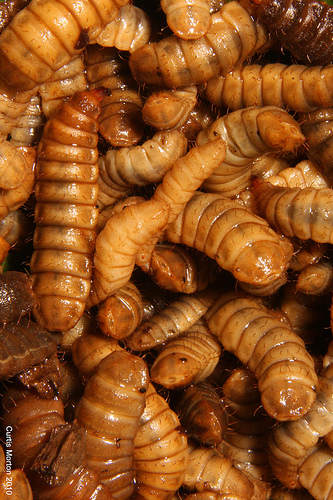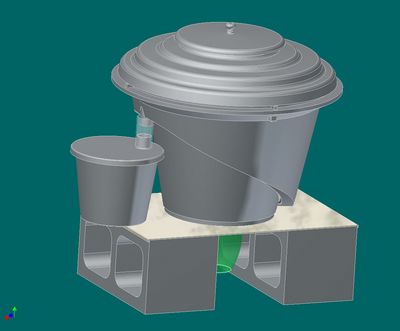Black Soldier Fly: Difference between revisions
| Line 38: | Line 38: | ||
*20 ton per week in a facility in China - [http://entomologytoday.org/2015/05/26/black-soldier-flies-as-recyclers-of-waste-and-possible-livestock-feed/] | *20 ton per week in a facility in China - [http://entomologytoday.org/2015/05/26/black-soldier-flies-as-recyclers-of-waste-and-possible-livestock-feed/] | ||
*Spend brewer's grain and grass clippings can grow house flies | *Spend brewer's grain and grass clippings can grow house flies | ||
==Efficiencies== | |||
*15 kg of putrescent material can be processed per m2 of surface area - at a conversion rate of 20% into BSF body mass. Source - [http://www.esrint.com/pages/bioconversion.html]. This indicates that 3 kg of BSF mass is produced per day from 15 kg of waste. If fish convert this to fish body mass, then 1.5 lb of fish mass growth can be sustained by this level of feeding. This appears to be comparable (same order of magnitude) to the 16 square meters of gutters (240 feet of 6" gutter) that would be required to produce 3lb of duckweed. | |||
Revision as of 03:15, 26 September 2015
Main > Food and Agriculture > Soil and compost
Parts of this text were taken an article by Dr. Paul Olivier - please read the original here.
Larvae of the black soldier fly (BSF), Hermetia illucens, can be used to convert many kinds of organic waste, including putrescent waste such as meat and dairy products. Soldier Grubs are not associated in any way with the transmission of disease. They do not bite, bother or pester humans in any way. In fact, they send out a (pheromonal?) signal to house flies: get lost !
Applications and Product Ecology
- Soldier Grubs can be fed to chickens or fish (see: aquaponics). They can become an important part of any integrated food and waste management system.
- Oils from Soldier Grubs has been proposed for making diesel - like biofuels and a protein-rich feed additive
- Whatever is left after the Soldier Grubs are done eating can be eaten by worms (vermicomposting), dramatically reducing the weight and volume of the compost
Open-source Black Soldier Fly composter
http://blacksoldierflyblog.com/bsf-bucket-composter-version-2-1/ - An open hardware project to build a grub composter for Black Soldier Fly. Includes automatic harvesting of the larvae. The grubs abandon the waste only when they have reached their final mature prepupal stage, and they crawl out of the waste and into a collection bucket without any mechanical or human intervention.
The design is for a 5 gallon (19l) bucket that could process a maximum of 1lb (454g) of food scraps a day. Performance testing shows that you can get about 1 kilo of grubs for every seven kilos of food waste you put in, so you could get a maximum of 7lb (3.17kg) of grubs a week from just a 5 gallon bucket. If the grubs are used as fish food in aquaponics, the grubs from this bucket could easily sustain an aquaponics system with a 5000l tank.
Further Links
- How to grow them - [1] and download - File:Bsf.pdf
- Scientific American article on BSF as fish food - [2]
- Black Soldier Fly Farming website
- Black Soldier Fly Blog
- Agroinnovations Podcast on BSF
- Wikipedia: Black Soldier Fly
- ESR International LLC - Dr. Paul Olivier and proprietary technologies: BioPod™ Classic, BioPod™ Plus, ProtaPod™
- Very detailed information from a project in Brazil (Dr. Paul Olivier)
Sourcing
- Larvae source - [3]
Building Bins
Production
- 20 ton per week in a facility in China - [4]
- Spend brewer's grain and grass clippings can grow house flies
Efficiencies
- 15 kg of putrescent material can be processed per m2 of surface area - at a conversion rate of 20% into BSF body mass. Source - [5]. This indicates that 3 kg of BSF mass is produced per day from 15 kg of waste. If fish convert this to fish body mass, then 1.5 lb of fish mass growth can be sustained by this level of feeding. This appears to be comparable (same order of magnitude) to the 16 square meters of gutters (240 feet of 6" gutter) that would be required to produce 3lb of duckweed.



